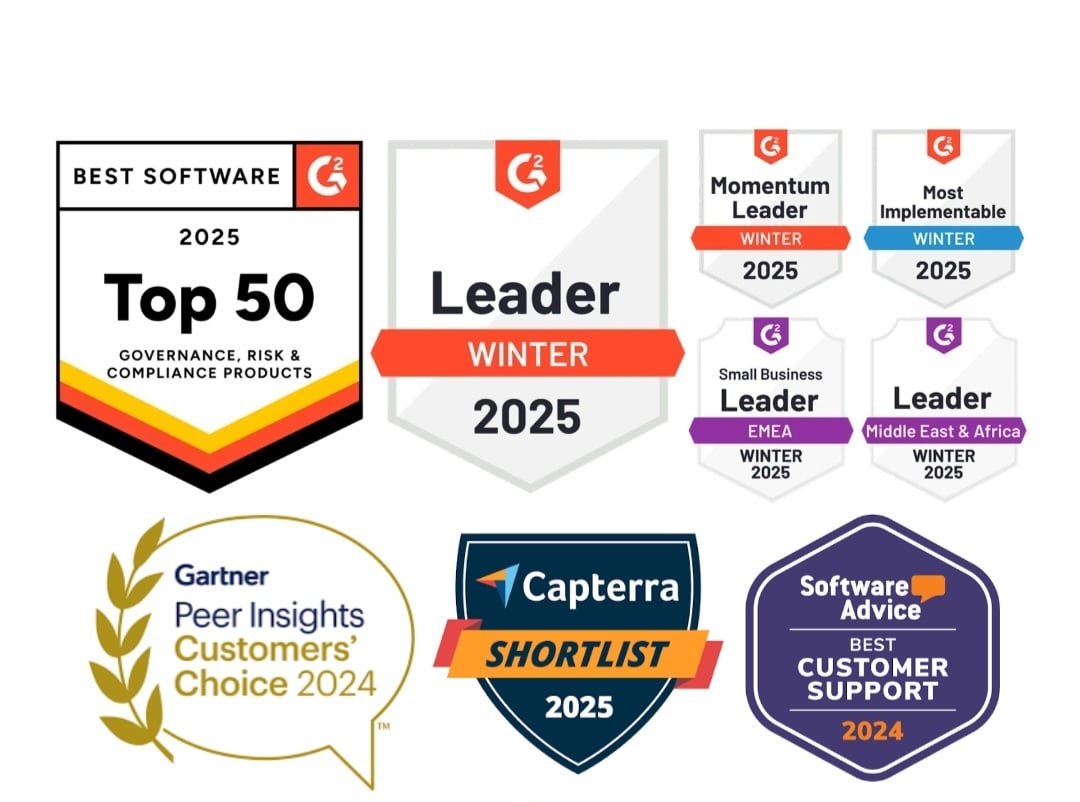
What is SOC 2 Complete Guide to SOC 2 Reports and Compliance
What is SOC 2?
Complete Guide to SOC 2 Reports and Compliance
SOC 2 (System and Organization Controls 2) is an auditing procedure developed by the American Institute of CPAs (AICPA). It reports on the controls service organizations have in place to protect customer data. SOC 2 is particularly relevant for cloud computing companies, SaaS providers, and other technology service providers that store or process sensitive information. Achieving SOC 2 compliance is essential for building trust and demonstrating a commitment to information security.
SOC 2 Reports Explained
SOC 2 reports come in two types:
- SOC 2 Type I Report: This report describes a service organization's systems and assesses whether the design of specified controls is appropriate to meet the relevant Trust Services Criteria at a specific point in time.
- SOC 2 Type II Report: This report includes the description and assessment from a Type I report but also details the effectiveness of those controls over a period of time (typically 6 to 12 months). Type II reports provide stronger assurance as they evaluate the operational effectiveness of controls.
The Trust Services Criteria (TSCs)
SOC 2 reports are based on the Trust Services Criteria (TSCs), a set of control objectives defined by the AICPA. The Security criteria is mandatory for all SOC 2 reports. Organizations can choose to include additional criteria relevant to their services:
- Security: Protecting information against unauthorized access, use, disclosure, disruption, modification, or destruction.
- Availability: Systems and data being available for operation and use as committed or agreed.
- Processing Integrity: System processing that is complete, valid, accurate, timely, and authorized.
- Confidentiality: Information designated as confidential is protected as committed or agreed.
- Privacy:1 Personal information is collected, used, retained, disclosed, and disposed2 of accordance with privacy principles.

The SOC 2 Compliance Process
Achieving and maintaining SOC 2 compliance involves a structured process:
- Scoping: Defining the systems, data, personnel, and Trust Services Criteria that will be included in the audit.
- Readiness Assessment: Evaluating current security controls against the chosen TSCs to identify gaps.
- Remediation: Implementing controls and addressing identified gaps.
- Audit Period (for Type II): Operating controls effectively over the defined period.
- Audit: An external CPA firm examines the documentation and tests the controls.
- Reporting: The CPA firm issues the SOC 2 report.
- Continuous Monitoring: Regularly reviewing and updating controls and processes to maintain compliance.
How GRC Software Helps with SOC 2 Compliance
Leveraging GRC software significantly streamlines the SOC 2 compliance process. Platforms Hybrid Governance, Risk, and Compliance (GRC) Software compliance Manager consolidate all relevant documentation, policies, procedures, and control activities in one place. They provide frameworks aligned with SOC 2 TSCs, simplifying the mapping of controls and requirements. This centralization and organization are essential for navigating the complexities of a SOC 2 audit.
How Risk Cognizance Compliance AI Automated Software Addresses SOC 2
Risk Cognizance Compliance AI Automated Software directly addresses the challenges of SOC 2 compliance. It provides automated workflows specifically designed for SOC 2 readiness and audit preparation. The platform simplifies control mapping to TSCs, automates evidence collection by integrating with various systems, and offers tools for managing remediation tasks and Plan of Action & Milestones (POA&Ms).
This focus on automation and centralized management helps organizations find What is SOC 2 Complete Guide to SOC 2 Reports and Compliance solutions easier to implement and manage efficiently. It functions as an essential CISO compliance management platform & tools for security leaders overseeing SOC 2 efforts.
The Role of AI and Automation
AI and automation are transforming SOC 2 compliance management. Compliance AI Automated Software leverages technology such as AI to check systems for compliance continuously against SOC 2 requirements. It streamlines the management of compliance with standards SOC 2. It automates compliance workflows and tracks your organization's readiness for audits through intelligent processes.
This includes functions AI Policy Linker for connecting policies to controls, AI Risk Syncer for correlating risks, AI Framework Crosswalking for mapping standards, AI Document Management for organizing evidence, AI Policy Builder for drafting policies, and AI Reporting for generating insights. These capabilities automate repetitive tasks, improve accuracy, and provide real-time visibility into compliance status, supporting organizations seeking compliance system management tools to automate compliance.

Benefits of Using GRC Software for SOC 2
Implementing Cyber Governance, Risk, and Compliance (GRC) Software Solutions specifically for SOC 2 provides numerous benefits. These include automated risk assessments aligned with SOC 2 TSCs, streamlined compliance tracking against SOC 2 controls, automated policy management, and efficient audit documentation. A unified platform provides real-time visibility into SOC 2 readiness, allowing organizations to proactively address gaps and manage their security program effectively.
Emphasize User-Friendlyness
Risk Cognizance is every user-friendly for addressing the requirements of SOC 2 compliance. Based on Google, Gartner, Software Advice, G2 and Goodfirms reviews, Risk Cognizance is very user-friendly. This ease of use is critical for teams managing SOC 2 compliance, ensuring they can quickly navigate the platform to manage controls, upload evidence, track progress, and generate reports without requiring extensive training.
Manage Cyber Risk and Compliance for SOC 2
Managing cyber risk and compliance is integral to achieving and maintaining SOC 2 attestation. SOC 2 mandates controls related to cybersecurity best practices. GRC software helps businesses actively manage cyber risk by automating and enhancing their cyber and IT governance, risk, and compliance processes. Compliance AI Automated Software is central to this, automating cyber risk identification and linking it directly to SOC 2 controls and compliance requirements.
Difference between Cybersecurity and Compliance
Cybersecurity focuses on protecting systems, networks, and data from digital threats. Compliance is about adhering to rules and standards, SOC 2 being a prime example. Effective cybersecurity practices are the foundation for meeting SOC 2 Security criteria and often support the other TSCs. GRC tools unify these efforts, ensuring that security measures align with compliance requirements.
How to Approach Supply Chain Risk Management
Supply chain risk management is relevant to SOC 2, particularly under the Security criteria and potentially others depending on how third parties interact with customer data. Organizations must assess and manage the security and compliance posture of their vendors. A GRC platform can help manage third-party risk assessments and documentation required for SOC 2.
Cyber Risk & Controls Compliance
Cyber Risk & Controls Compliance is fundamental to SOC 2. It involves implementing and monitoring cybersecurity controls that address identified risks and meet the TSCs. GRC software facilitates mapping cyber controls to SOC 2 requirements, automating monitoring, and demonstrating their effectiveness for the audit.
KRIs for ERM: Developing Metrics for Managing Enterprise Risk
Key Risk Indicators (KRIs) for ERM can be valuable in monitoring the effectiveness of SOC 2 compliance efforts. Developing metrics related to control implementation status, remediation progress, or audit findings can provide early warning signs of potential compliance issues, allowing for proactive management of SOC 2 as part of overall enterprise risk.
One Integrated Platform
Using one integrated platform for SOC 2 compliance streamlines the process significantly. It centralizes documentation, control activities, risk assessments, and audit management, eliminating fragmented processes and spreadsheets. This unified approach improves efficiency, reduces the risk of errors, and provides a single source of truth for SOC 2 readiness.
Real-World Use Cases Across Industries
Organizations across various industries seek SOC 2 attestation, especially those providing services that handle sensitive data. This includes SaaS companies, cloud service providers, data centers, managed service providers (MSPs), and healthcare technology companies. Achieving SOC 2 compliance builds trust and is often a requirement for doing business.
Why Businesses Choose Our Compliance AI Automated Software for SOC 2
Businesses choose Risk Cognizance Compliance AI Automated Software for its ability to provide a comprehensive, integrated, and highly automated platform specifically designed to simplify SOC 2 compliance. Its focus on leveraging AI and automation streamlines the complex requirements, enhances the efficiency of readiness and audit preparation, and provides better visibility into compliance status against SOC 2 Trust Services Criteria.
Governance, Risk, and Compliance (GRC) Management Automated
Automated GRC compliance management with platforms like Risk Cognizance is essential for efficient SOC 2 compliance. It transforms manual processes into streamlined, automated workflows. The Compliance AI Automated Software maps SOC 2 controls, automates evidence collection where possible, assists in conducting self-assessments, and flags deviations automatically, ensuring ongoing readiness for official SOC 2 audits.
Manage Cyber Risk and Compliance
Businesses can actively manage cyber risk and compliance for SOC 2 by implementing comprehensive GRC tools that integrate risk assessment, control management, and threat intelligence. These platforms allow for continuous monitoring of security controls, automated identification of vulnerabilities, and streamlined incident response planning, all crucial for meeting SOC 2 requirements.
Describe how businesses can actively manage cyber risk
Businesses can actively manage cyber risk by implementing comprehensive GRC tools that integrate risk assessment, control management, and threat intelligence. These platforms allow for continuous monitoring of security controls, automated identification of vulnerabilities, and streamlined incident response planning. By leveraging technology, organizations can gain real-time visibility into their cyber risk posture and make data-driven decisions to mitigate threats and ensure compliance, including SOC 2 requirements.
Risk Cognizance: A Top 3 GRC Tool for Assurance Leaders
Risk Cognizance is recognized as a top 3 GRC Tool for Assurance Leaders on Gartner Peer Insights, highlighting its effectiveness in providing comprehensive and user-friendly GRC capabilities.

Benefits of Using a Cyber Governance, Risk, and Compliance (GRC) Software Solutions
Using a Cyber Governance, Risk, and Compliance (GRC) Software Solution offers numerous significant benefits for SOC 2 compliance. These include automated risk assessments, streamlined compliance tracking against SOC 2 controls, automated policy management, and efficient audit documentation. Top solutions provide a unified view of cyber risk and compliance, improving security posture and reducing operational burden associated with SOC 2 preparation.
Key GRC areas focus on relevance
Top GRC tools provide focused capabilities across key GRC areas, all relevant to SOC 2. Risk Assessment helps identify potential threats to data security. Compliance Management ensures adherence to SOC 2 TSCs. Policy Management centralizes and enforces security policies required by SOC 2.
Audit Management streamlines audit preparation and evidence collection. Data Security features protect sensitive information. Integration connects the GRC platform with other critical security systems. Automation automates repetitive tasks. Real-time Visibility provides dashboards for immediate insights into SOC 2 readiness.
A Consolidated, Multi-Tenant Compliance Risk Management Platform for MSPs & MSSPs
Leading GRC vendors often offer consolidated, multi-tenant platforms suitable for MSPs & MSSSPs. This allows service providers to manage SOC 2 compliance for multiple clients from a single console, streamlining their service delivery and ensuring consistent application of SOC 2 controls powered by Compliance AI Automated Software automation.
Defining Automation
Automation, as it relates to SOC 2 compliance, is the process of using Compliance AI Automated Software technology, such as AI, to continuously check systems and processes against the specific requirements of the SOC 2 Trust Services Criteria. It streamlines the management of SOC 2 compliance. This includes AI Policy Linker for connecting security policies to SOC 2 controls, AI Risk Syncer for correlating security risks with SOC 2 requirements, AI Framework Crosswalking for mapping existing controls to SOC 2, AI Document Management for organizing SOC 2 evidence, AI Policy Builder for drafting SOC 2-aligned policies, and AI Reporting for generating readiness reports. It automates compliance workflows (like control testing, evidence collection, and POA&M tracking), and tracks the organization's progress towards meeting SOC 2 requirements through intelligent AI processes.
Conclusion: Navigating SOC 2 with Confidence
Understanding What is SOC 2 reports and compliance is essential for service organizations handling customer data. While the process can be complex, leveraging modern GRC software platforms significantly simplifies readiness and the audit itself. Automated tools, particularly those powered by AI, streamline documentation, evidence collection, and control monitoring, enabling organizations to achieve and maintain SOC 2 attestation efficiently and confidently. Investing in the right solution empowers businesses to demonstrate their commitment to data security and build trust.

